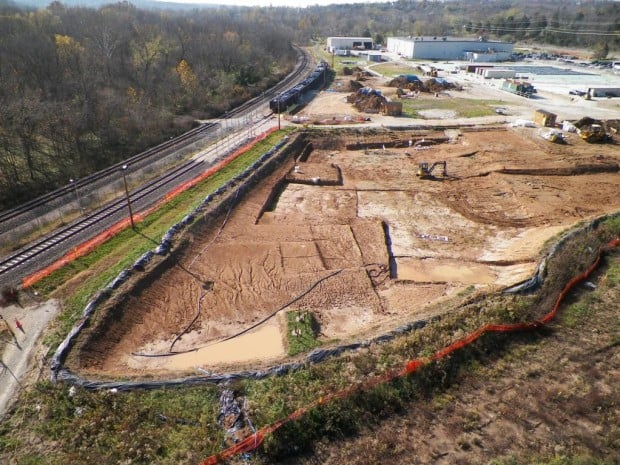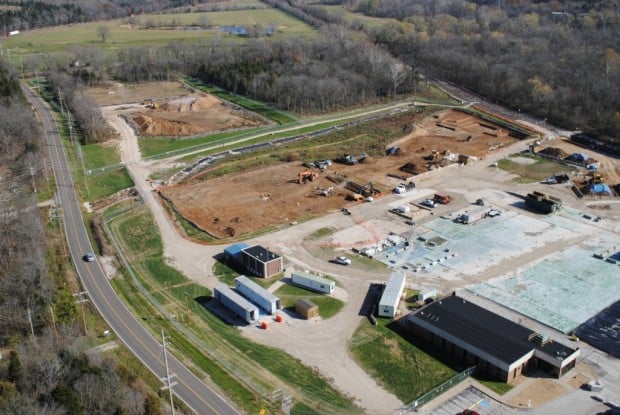HEMATITE ŌĆó For decades, a factory in rural Jefferson County churned out nuclear fuel and its workers buried radioactive waste in pits.
It was the oldest nuclear fuel manufacturing plant in the country when Westinghouse Electric Co. acquired the plant in 2000 and shuttered it the next year.
ŌĆ£Uranium went in and fuel went out,ŌĆØ said Bob Copp, the Westinghouse project manager charged with cleaning up what stayed behind, including radioactive garbage.
These days, the only thing being shipped away is contaminated soil in rail cars ŌĆö each loaded with 284,000 pounds of dirt that costs $23,000 to transport and store ŌĆö bound for a landfill in the Owyhee Desert of Idaho that accepts low-level radioactive material.
ItŌĆÖs part of a $200 million cleanup of the site by Westinghouse. The intensive process of removing the waste from the pits and refilling the holes with clean soil began in March and is expected to be done in the summer, Copp said.
People are also reading…
The plant is ringed by a chain-link fence topped with barbed wire and signs warning of the radioactive material behind it. Flags stuck in the ground mark ŌĆ£hot spotsŌĆØ where such material has been detected. Pollution from heavy metals and other chemicals also lingers.
Past owners of the plant buried radioactive contaminated waste such as old equipment, gloves, shoe covers and overalls on the property in at least 40 unlined pits, the deepest of which is 26 feet.
Copp expects to remove about 2.3 million cubic feet of soil by the time the project is done, with roughly half of that coming from the pits. The total site is 267 acres, although only 28 acres require remediation, said Copp, who has done work on nuclear reactors in the United Kingdom and the Ukraine.
He lives in Idaho Falls, Idaho, and rents an apartment in Festus. He moved in January and plans to stay until the job is done, which will likely be in late 2014.
A LONG HISTORY
The Hematite factory dates back to 1956, when Mallinckrodt Chemical Works built it on farmland. It went through a series of owners, and until 1974, it produced high-enriched nuclear fuel for the NavyŌĆÖs nuclear submarine program and other reactor programs, according to the U.S. Nuclear Regulatory Commission.
From 1974 until its 2001 closure, it manufactured nuclear fuel rods for commercial power plants.
Westinghouse started tearing down buildings on the site in 2002, Copp said, including two barns on the property that were there when Mallinckrodt bought the land. They stored contaminated equipment.
The cleanup rules are strict. For example, workers who need water must leave the pits, remove their gloves, go inside and drink. Water is sprayed on the pits daily to prevent potentially polluted dust from entering the air.
Even the powerful heavy equipment is only allowed to scrape six inches of soil at a time so instruments can accurately detect radioactive material.
ŌĆ£ItŌĆÖs a very disciplined process,ŌĆØ Copp said.
TheyŌĆÖve found rotted, metal drums and other trash, such as a construction remnants, and even a tailgate from a Studebaker pickup truck ŌĆö the last Studebaker was made in 1966.
The Nuclear Regulatory Commission believes the land will be available for ŌĆ£residential, agricultural, and light industrial use in the future.ŌĆØ
Copp said itŌĆÖs unknown what Westinghouse will do with the property, which sits in a remote area with few houses directly nearby, once the polluted materials are gone.
Dennis Diehl, director of the Jefferson County Health Department, said he was pleased with how the cleanup has progressed and that Westinghouse has held public meetings to give updates.
ŌĆ£TheyŌĆÖve kept everybody informed on whatŌĆÖs been going on,ŌĆØ he said.
BEYOND THE PLANT
Clarissa Eaton, who lived a few miles from the plant for about nine years, filed a petition in 2008 on behalf of a group of former Hematite workers to secure a special designation that would allow compensation claims to be approved without forcing them to prove how they were exposed to the radiation.
Many of the Hematite workers have been seeking help since a federal compensation program was launched in 2001. Since then, the federal government has paid millions of dollars to former nuclear workers who were exposed to radiation through the program managed by the U.S. Department of Labor.
The special designation recognizes that records at many former nuclear weapons production plants have been lost or destroyed, making it difficult for some workers to get compensation.
Eaton said thatŌĆÖs what happened at the Hematite plant. One of the employees in her petition was Edward Patterson of Portageville, Mo., who worked at the plant from 1967 to 1971 as a chemical technician and had bladder cancer. He had been seeking compensation since 2004 but died earlier this year, Eaton said.
But in September, the Advisory Board on Radiation Worker Health ruled that enough information was available to determine how Hematite workers may have been sickened. It followed the recommendation of the National Institute for Occupational Safety and Health and denied the request for the designation that would have allowed Hematite workers to bypass the step of proving their claims on a case-by-case basis.
ŌĆ£It was like a slap in the face for these people,ŌĆØ said Eaton, who moved with her family to Kokomo, Ind., about four years ago after her husband lost his job at the Chrysler plant.
Still, Hematite workers have been able to get compensation from the program. As of Monday, they had been paid more than $7.2 million, according to the Labor Department.
Eaton also got an undisclosed settlement from the company for chemical contamination in her well after a court fight that spanned several years.
She and her husband, who have three children, found out their well was contaminated in 2002. Other neighbors discovered the same thing and sought compensation. The Eatons hired an attorney, who negotiated a $26,000 settlement with companies that owned the plant. But the Eatons argued they never approved such a settlement and that their attorney didnŌĆÖt have authority to accept it. The appeal reached the Missouri Supreme Court, where Eaton argued her case without a lawyer and won a unanimous decision that sent the case back to circuit court.
The Eatons ultimately reached a confidential settlement.
ŌĆ£We were ready for it to go away,ŌĆØ Eaton said.










